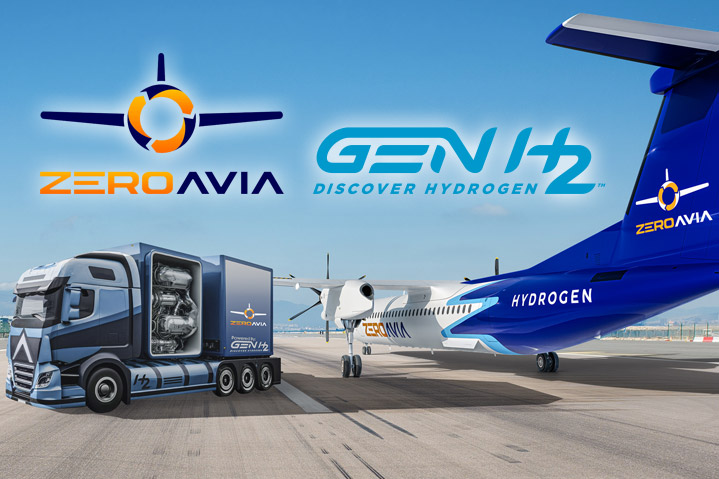
Those of us at the forefront of building the infrastructure for a hydrogen-powered future have always considered its broad use in aviation to be inevitable. As new technologies capable of deploying liquid hydrogen continue to emerge, the consensus for its utilization in aviation is growing.
Last week, McKinsey & Company published a report titled Target True Zero: Infrastructure for Alternative Propulsion Flight that declared, “hydrogen-powered aircraft are expected to account for 89 to 96 percent of electric power demand for novel propulsion in aviation by 2050.” This number represents the annual electric power consumption required to support alternative propulsion encompassing aircraft battery charging, hydrogen cold storage and pumping, hydrogen liquefaction, and hydrogen electrolysis.
To put it in practical terms, the McKinsey report states: “As alternative propulsion gains ground, airports will need more energy for their on-site operations than they do today. For an airport that is a large hub looking to invest in on-site hydrogen liquefaction and charging for battery-electric-powered aircraft, total on-site electricity consumption for terminals, ground support, and other uses could be between 1,250 and 2,450 gigawatt-hours per year, which is about five to ten times more electricity than London Heathrow currently consumes. To meet these demands, airports will need to take steps to upgrade grid connections, local power distribution infrastructure, and their own power stations.”
To build local power distribution infrastructure, the goal is to allow liquid hydrogen utilizers to break traditional geographic constraints so that they can get LH2 on demand wherever their businesses require – in this case, to provide airside power stations. GenH2 is proud to report that we are well beyond the hypothetical stage. GenH2 offers hydrogen liquefaction, storage and dispensing systems ranging from 20kg/day up to 5000 Kg/day that are capable of working airside as a ground support refueling unit and as a primary source of LH2 fuel in support of airport operations.
McKinsey highlighted the need for the aviation industry “to partner with other industries to secure enough green electricity and hydrogen for alternative propulsion in a supply-constrained environment and to have a voice in the future of the hydrogen ecosystem.” In fact, we recently entered a partnership with ZeroAvia to develop liquid hydrogen aviation infrastructure solutions for use in airport environments. This will allow us to develop airside LH2 infrastructure solutions that will establish the foundation for dedicated ground support for ZeroAvia aircraft.
This is a worldwide effort. A recent report from global research powerhouse Steer Group analyzing the cost of hydrogen aircraft provides insight. Steer was appointed by Transport & Environment and the European Climate Foundation to undertake a study to “provide a quantification of the costs associated with the development, deployment and operation of hydrogen-powered aircraft and supporting infrastructure within Europe, based on current aircraft and supporting infrastructure rollout ambitions.”
The report echoed our assertions in stating that “the use of hydrogen aircraft will require major changes to airport infrastructure” requiring the cryogenic storage, distribution and fueling facilities we have been developing. The report also noted that, “As with fuel supply infrastructure, many of the challenges associated with airport infrastructure are driven by the magnitude of the costs and uncertainty for airports and airlines whether the other party will also invest in hydrogen equipment or infrastructure.” In order to address fuel supply infrastructure, the report identified potential government policies that could be enacted at a national or EU level to increase supply capacity.
In the United States, the bipartisan infrastructure law signed by President Joe Biden last year included $8 billion for a program to establish six to 10 regional “hydrogen hubs” around the nation. The program aims “to accelerate the use of clean hydrogen by creating a network of producers, consumers, and local connective infrastructure to accelerate the use of hydrogen as a clean energy source.” The production, processing, storage, delivery, and end-use of clean hydrogen, including innovative uses in the industrial sector, are crucial to the DOE’s strategy to reduce carbon emissions.
A Hydrogen Hub is a network of infrastructure located in close proximity which integrates a number of hydrogen-based energy services that connect hydrogen producers and consumers. These services will match the supply and demand for hydrogen energy and will initially be focused on locations of suitable demand. The clustered design of a centralized Hub allows for the sharing of technology and infrastructure creating economies of scale and lower unit costs of energy for each service that shares the infrastructure. The challenge has always been transporting it from the hub where hydrogen is produced, to where it is needed. With the capability to produce and store liquified hydrogen where and when it is needed, the tipping point has been reached and the hydrogen economy is here. The aviation industry joins other end users for hydrogen liquefaction and storage that include fuel station operators trucking companies, mining companies, ship bunkering companies, and data centers.
The McKinsey report is correct to emphasize the importance of aviation in its net-zero equation. We have proven that energy and aviation industry partners are ready to meet the hydrogen future.
Greg Gosnell is CEO of U.S. hydrogen infrastructure leader GenH2, where he is responsible for working with strategic partners and customers to ensure GenH2 can support their unique needs for hydrogen production, liquefaction, storage, and dispensing. He has over three decades of experience in senior leadership positions providing strategic technology and business solutions. Learn more at www.DiscoverHydrogen.com.
By: Greg Gosnell, CEO of GenH2
Read the most up to date Fuel Cell and Hydrogen Industry news at FuelCellsWorks




